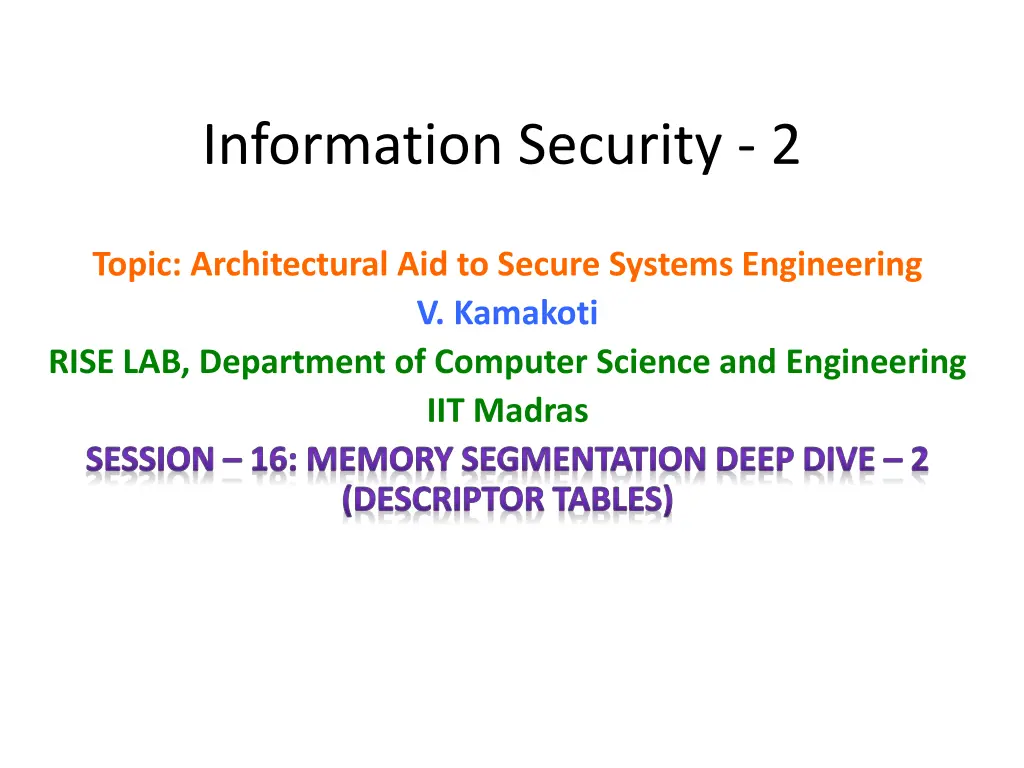
Memory Segmentation Deep Dive: Descriptor Tables Overview
Explore the architecture behind memory segmentation with a focus on descriptor tables, including the Global Descriptor Table (GDT), Interrupt Descriptor Table (IDT), and Local Descriptor Table (LDT). Learn about the structure of these tables, the locations in memory where they are stored, and how segment selectors are used to point to segments in the tables. Understand the rules for loading segment selectors into segment registers for enhanced memory protection in system engineering.
Download Presentation

Please find below an Image/Link to download the presentation.
The content on the website is provided AS IS for your information and personal use only. It may not be sold, licensed, or shared on other websites without obtaining consent from the author. If you encounter any issues during the download, it is possible that the publisher has removed the file from their server.
You are allowed to download the files provided on this website for personal or commercial use, subject to the condition that they are used lawfully. All files are the property of their respective owners.
The content on the website is provided AS IS for your information and personal use only. It may not be sold, licensed, or shared on other websites without obtaining consent from the author.
E N D
Presentation Transcript
Information Security - 2 Topic: Architectural Aid to Secure Systems Engineering V. Kamakoti RISE LAB, Department of Computer Science and Engineering IIT Madras SESSION 16: MEMORY SEGMENTATION DEEP DIVE 2 (DESCRIPTOR TABLES)
Descriptor Tables Descriptors are stored in three tables: Global descriptor table (GDT) Maintains a list of most segments May contain special system descriptors The first descriptor is a null descriptor Interrupt descriptor table (IDT) Maintains a list of interrupt service routines Local descriptor table (LDT) Is optional Extends range of GDT Is allocated to each task when multitasking is enabled The first descriptor is a null descriptor
Locations of the tables In Memory Pointed out by GDTR, LDTR and IDTR for the GDT, LDT and IDT respectively. The GDTR and IDTR are 48-bits in length, the first 16- bits (least significant) storing the size (limit) of the table and the remaining storing a 32-bit address pointing to the base of the tables Limit = (no. of descriptors * 8) - 1 LLDT stores a 16-bit selector pointing to an entry in the GDT.
Segment Selectors Out of several segments described in your GDT and LDT, which of the segment(s) that are currently being used are pointed to by the 16-bit CS,DS,ES,FS,GS and SS registers. Each store a selector Since descriptors are at 8-byte boundaries, the 16-bit selectors store the first most significant 13 bits to point to the corresponding descriptor. The bit 2 is the T1 bit, which when 0 (1) implies the selector is pointing to a descriptor in GDT (LDT). The bits (0-1) are the Request Privilege Level (RPL) bits used for privilege assignments.
Loading Segment Selectors into segment registers Whenever segment registers are loaded, the following rules are checked by the processor and if violated an exception is raised thus giving high degree of memory protection Rule 1: Index field of the selector within limits of the GDT/LDT to be accessed else raise a General Protection Fault exception.
Loading Segment Selectors into segment registers Rule 2: Loading a selector into DS,ES,FS or GS that points to a non-readable segment results in an exception Rule 3: For loading into SS, the segment pointed to should be readable and writable Rule 4: For loading into CS, the segment should be executable type Rule 5: Privilege level check rules to be described later
Loading segment selectors All segment registers except CS may be loaded using MOV, LDS, LES, LFS, LGS and LSS. The CS is loaded using a JMP or a CALL instruction discussed later
Local Descriptor Table Is defined by a system descriptor (S=0) in GDT which is pointed to by the LDT. The 64-bit descriptor in GDT 0000010 Base 0000 Limit Base Address Limit P Address 15-0 23-0 19-16 31-24
End of Session-16 Thank You
